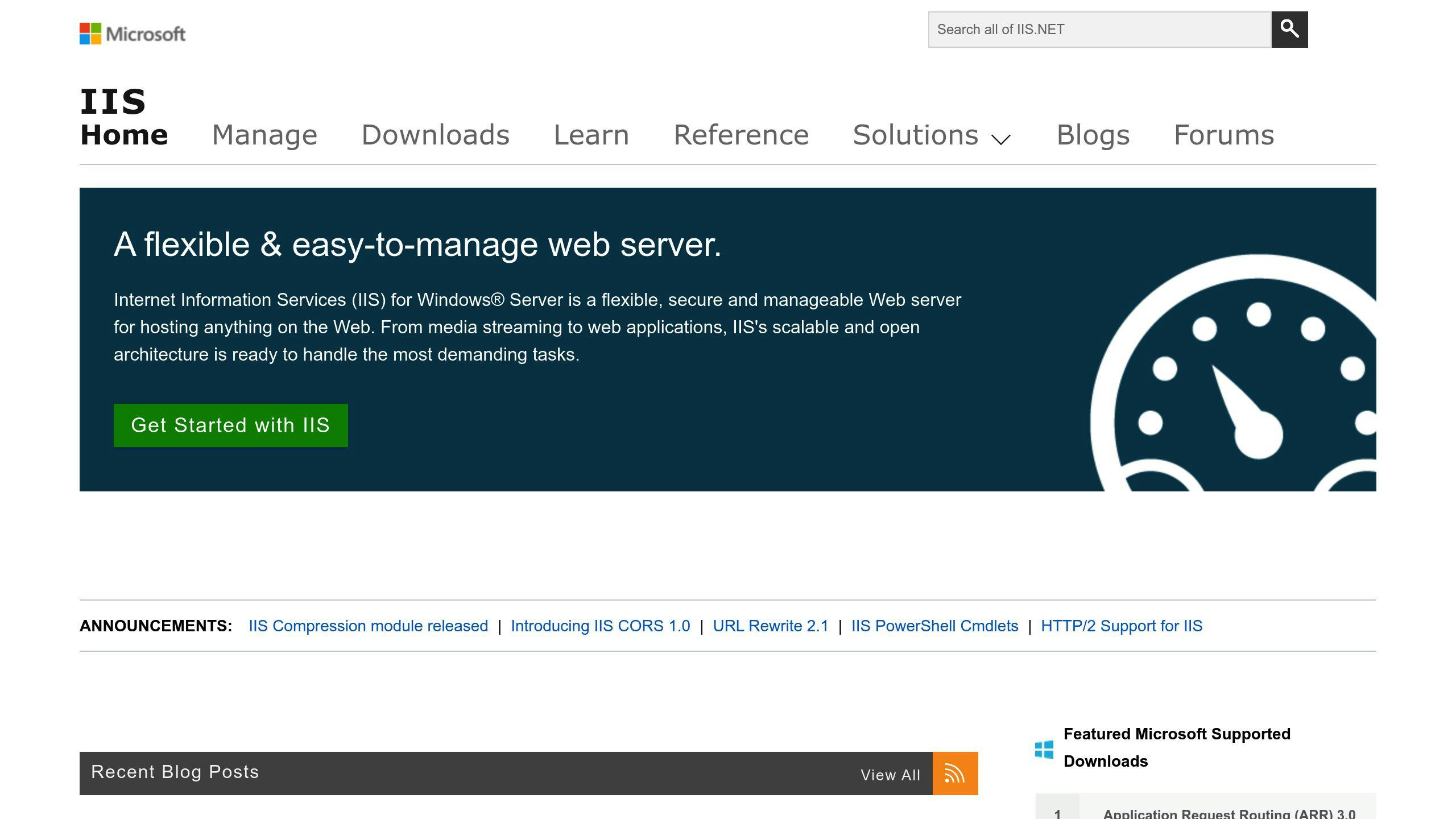Want to speed up your ASP.NET MVC app? Here's how to slash network latency:
- Use effective caching
- Improve database queries
- Use Content Delivery Networks (CDNs)
- Reduce HTTP requests
- Turn on compression
- Improve routing and controller actions
- Use async programming
- Speed up view rendering
- Use browser caching
- Check and measure performance
Quick Comparison:
| Tip | Impact | Ease of Implementation |
|---|---|---|
| Caching | High | Medium |
| Database optimization | High | Hard |
| CDNs | High | Easy |
| Reduce HTTP requests | Medium | Medium |
| Compression | Medium | Easy |
| Routing improvements | Low | Easy |
| Async programming | High | Medium |
| View rendering | Medium | Medium |
| Browser caching | Medium | Easy |
| Performance monitoring | N/A | Medium |
These tactics can dramatically cut load times. Even a 100ms improvement can boost user happiness and conversions. Let's dive in and speed up your app!
Related video from YouTube
Network Latency Basics
Let's talk about network latency in ASP.NET MVC apps. What causes it? How does it affect your app? Let's find out.
What Causes Latency
Latency in ASP.NET MVC apps isn't just one thing. It's a mix:
- Distance between server and users
- Network quality
- Server load
- Code efficiency
Here's a quick look:
| Cause | Latency Impact |
|---|---|
| Distance | +1 ms per 100 km |
| Network | Varies (can be high) |
| Server Load | 10-100+ ms |
| Code | 10-1000+ ms |
How Latency Affects Performance
Latency isn't just tech talk. It hits your app hard:
- Frustrates users
- Lowers conversion rates
- Hurts SEO rankings
The numbers don't lie:
- 100 ms delay? 7% fewer conversions.
- 3+ second load time? 53% of mobile users leave.
"In the web world, every millisecond counts." - Steve Souders, Web Performance Expert
Think about this:
- 1 second extra load time? 4.3% less revenue.
- 500 ms delay? 20% less search traffic.
Bottom line? Latency isn't just tech. It's business. And it needs fixing, now.
1. Use Effective Caching
Caching can slash latency in ASP.NET MVC apps. Here's how:
Output Caching
Output caching stores rendered views. It's like a time machine for your content. Add this to a controller action:
[OutputCache(Duration=86400, VaryByParam="none")]
public ActionResult Index()
{
// Action logic here
}
This caches the output for 24 hours. But watch out! Don't cache personal stuff on the server. That's a recipe for mix-ups.
Data Caching
Data caching is like a memory bank for your app's favorite data. It cuts down on database chats.
How to do it right:
- Cache stuff that doesn't change much
- Set smart expiration times
- Use cache dependencies to keep things fresh
Distributed Caching
Distributed caching is like having a photographic memory spread across multiple brains. It's fast and scalable.
ASP.NET Core gives you options:
| Cache Type | When to Use | How to Set Up |
|---|---|---|
| Distributed Memory Cache | Testing | builder.Services.AddDistributedMemoryCache(); |
| SQL Server Cache | With existing SQL Server | Use sql-cache tool |
| Redis Cache | For speed demons | builder.Services.AddStackExchangeRedisCache(); |
Redis is the cool kid on the block. Stack Overflow and GitHub use it. Here's how you can too:
builder.Services.AddStackExchangeRedisCache(options =>
{
options.Configuration = "localhost";
options.InstanceName = "SampleInstance";
});
Pro tip: Keep your cache close. Distance equals latency.
2. Improve Database Queries
Let's turbocharge your ASP.NET MVC app's database queries:
Write Better Queries
- Pick specific columns, not
SELECT * - Use EXISTS instead of COUNT
- Filter with WHERE before grouping
- Use JOINs over linked subqueries
- Add smart indexes
Before:
SELECT * FROM Customers WHERE Country = 'USA'
After:
SELECT CustomerID, CustomerName FROM Customers WHERE Country = 'USA'
Go Async
Async ops keep your app responsive. It's like multitasking while waiting for coffee.
.NET Framework 4.5+ async methods:
| Method | Use |
|---|---|
OpenAsync |
Connections |
ExecuteReaderAsync |
SELECTs |
ExecuteNonQueryAsync |
INSERTs, UPDATEs, DELETEs |
ExecuteScalarAsync |
Single values |
Example:
using (var conn = new SqlConnection(connectionString))
{
await conn.OpenAsync();
var cmd = new SqlCommand("SELECT TOP 2 * FROM Orders", conn);
using (var reader = await cmd.ExecuteReaderAsync())
{
while (await reader.ReadAsync())
{
Console.WriteLine(reader[0]);
}
}
}
Use Stored Procedures
Think of stored procedures as pre-cooked meals for your database. They're faster because they're pre-compiled, cached, and reduce network traffic.
Example stored procedure:
CREATE PROCEDURE GetCustomerOrders @CustomerID INT
AS
BEGIN
SELECT * FROM Orders WHERE CustomerID = @CustomerID
END
Using it in C#:
using (var conn = new SqlConnection(connectionString))
{
var cmd = new SqlCommand("GetCustomerOrders", conn);
cmd.CommandType = CommandType.StoredProcedure;
cmd.Parameters.AddWithValue("@CustomerID", 1);
await conn.OpenAsync();
using (var reader = await cmd.ExecuteReaderAsync())
{
// Process results
}
}
3. Use Content Delivery Networks (CDNs)
CDNs can make your ASP.NET MVC app faster by serving static content from nearby servers. Here's the scoop:
Why Use CDNs?
CDNs spread files around the world, so users get content faster. They're perfect for:
- Images
- Videos
- CSS
- JavaScript
Plus, they cut your bandwidth costs. Win-win.
Setting Up CDNs in ASP.NET MVC

Here's how to add a CDN:
1. Create an Azure storage account
2. Upload your static files
3. Set up a CDN for the storage
Use this helper method for CDN links:
public static MvcHtmlString CDNLink(this HtmlHelper html, string tagName, string contentTag, string contentUrl, object htmlAttributes) {
var contentLink = new TagBuilder(tagName);
var contentServerUrl = ConfigurationManager.AppSettings["ContentServerUrl"];
contentServerUrl = string.IsNullOrEmpty(contentServerUrl) ? "{0}" : contentServerUrl;
contentLink.MergeAttribute(contentTag, string.Format(contentServerUrl, contentUrl));
contentLink.MergeAttributes((IDictionary<string, string>)htmlAttributes, true);
return MvcHtmlString.Create(contentLink.ToString());
}
In your view:
<%=html.cdnlink("link", new { {"rel", "stylesheet"}, {"type", "text/css"} }) %>
What If CDNs Fail?
CDNs can go down. Be ready:
1. Set up fallbacks
2. Use local backups
For scripts, check if the CDN loaded:
var jquery = new ScriptBundle("~/bundles/jquery", "//ajax.aspnetcdn.com/ajax/jquery/jquery-2.0.0.min.js")
.Include("~/Scripts/jquery-{version}.js");
jquery.CdnFallbackExpression = "window.jQuery";
bundles.Add(jquery);
For CSS, use JavaScript to check and load local if needed:
function UrlExists(url){
var http = new XMLHttpRequest();
http.open('HEAD', url, false);
http.send();
return http.status != 404;
}
if (!UrlExists('CSS URL HERE')) {
AddLocalCss();
}
function AddLocalCss(){
document.write('<link rel="stylesheet" type="text/css" href="LOCAL CSS URL HERE">');
}
4. Reduce HTTP Requests
Want to speed up your ASP.NET MVC app? Cut down on HTTP requests. Here's how:
Bundling and Minifying
Combine and shrink your CSS and JS files. It's like packing for a trip - fewer, smaller bags are easier to carry.
For ASP.NET MVC 4+:
bundles.Add(new StyleBundle("~/Content/css").Include(
"~/Content/site.css",
"~/Content/bootstrap.css"));
Don't forget: BundleTable.EnableOptimizations = true;
The results? Check this out:
| Metric | With B/M | Without B/M | Change |
|---|---|---|---|
| File Requests | 9 | 34 | 256% fewer |
| KB Sent | 3.26 | 11.92 | 266% less |
| Load Time | 510 MS | 780 MS | 53% faster |
CSS Sprites
Think of CSS sprites as a digital collage. Combine small images into one big one, then use CSS to show the right part:
.icon {
background-image: url('sprite.png');
width: 16px;
height: 16px;
}
.icon-home { background-position: 0 0; }
.icon-user { background-position: -16px 0; }
One image request instead of many. Smart, right?
Lazy Loading
Why load everything at once? Lazy loading is like a "just-in-time" delivery for your images.
HTML5 makes it easy:
<img src="image.jpg" loading="lazy" alt="Description">
Or try Lozad.js:
const observer = lozad();
observer.observe();
These tricks can slash your HTTP requests by half or more. Your ASP.NET MVC app will thank you.
5. Turn On Compression
Want a quick win for your ASP.NET MVC app's speed? Turn on compression. It's like shrink-wrapping your data for faster delivery.
Using Gzip Compression
Gzip is the top choice for web content compression. It squeezes your HTTP responses before they travel.
Check out what Gzip can do:
| Content Type | Before Gzip | After Gzip | Size Reduction |
|---|---|---|---|
| HTML | 5.15 KB | 2.01 KB | 61% |
| CSS | 159.06 KB | 28.86 KB | 82% |
| JavaScript | 161.54 KB | 46.94 KB | 71% |
Gzip can slash your file sizes by over half. That's a big boost for network speed.
Setting Up IIS Compression

Here's how to turn on Gzip in IIS:
- Open IIS Manager
- Select your website
- Double-click 'Compression'
- Check both compression options
- Apply changes
For more control, add this to your web.config:
<system.webServer>
<httpCompression directory="%SystemDrive%\inetpub\temp\IIS Temporary Compressed Files">
<scheme name="gzip" dll="%Windir%\system32\inetsrv\gzip.dll" staticCompressionLevel="9" />
<dynamicTypes>
<add mimeType="text/*" enabled="true" />
<add mimeType="message/*" enabled="true" />
<add mimeType="application/x-javascript" enabled="true" />
<add mimeType="application/json" enabled="true" />
<add mimeType="*/*" enabled="false" />
</dynamicTypes>
<staticTypes>
<add mimeType="text/*" enabled="true" />
<add mimeType="message/*" enabled="true" />
<add mimeType="application/javascript" enabled="true" />
<add mimeType="*/*" enabled="false" />
</staticTypes>
</httpCompression>
<urlCompression doStaticCompression="true" doDynamicCompression="true" />
</system.webServer>
This setup compresses static and dynamic content, including JSON from your Web API.
Just a heads up: compression uses CPU power. If your server's already maxed out, keep an eye on it after turning this on.
sbb-itb-29cd4f6
6. Improve Routing and Controller Actions
Let's boost your ASP.NET MVC app's speed by tweaking routing and controller actions.
Better Route Setup
Good routing = faster app. Here's how:
routes.MapRoute(
name: "Default",
url: "{controller}/{action}/{id}",
defaults: new { controller = "Home", action = "Index", id = UrlParameter.Optional }
);
Put specific routes first. Want more control? Use attribute routing:
[RoutePrefix("MyHome")]
[Route("{action=index}")]
public class HomeController : Controller {
public ActionResult Index() { return View(); }
public ActionResult About() { return View(); }
}
Async Controller Actions
Async actions = faster app. Here's the trick:
public async Task<ActionResult> Index()
{
var data = await _repository.GetDataAsync();
return View(data);
}
Focus on I/O-bound ops. And remember: async Task, not async void.
Cut Down Redirects
Too many redirects? App slows down. Here's a quick guide:
| Method | When to Use | Example |
|---|---|---|
View() |
Show a view | return View(); |
RedirectToAction() |
Go to another action | return RedirectToAction("MyIndex"); |
RedirectToRoute() |
Use a named route | return RedirectToRoute("MyRoute"); |
Pro tip: For HTTP to HTTPS, use a static landing page with a secure login link.
7. Use Async Programming
Async programming in ASP.NET MVC boosts your app's request handling. Here's how to do it right:
Using Async/Await
Async/await makes non-blocking code a breeze. In your MVC controllers:
public async Task<ActionResult> Index()
{
var data = await _repository.GetDataAsync();
return View(data);
}
This frees up threads during I/O operations, ramping up concurrent request handling.
"Asynchronous programming doesn't improve performance, it improves throughput." - Author Unknown
Parallel Processing
Got independent tasks? Use parallel processing:
public async Task<IEnumerable<UserDto>> GetUsersInParallel(IEnumerable<int> userIds)
{
var tasks = userIds.Select(id => client.GetUser(id));
var users = await Task.WhenAll(tasks);
return users;
}
This fetches multiple users at once, slashing execution time.
For big datasets, try batch processing:
public async Task<IEnumerable<UserDto>> GetUsersInParallelFixed(IEnumerable<int> userIds)
{
var users = new List<UserDto>();
var batchSize = 100;
int numberOfBatches = (int)Math.Ceiling((double)userIds.Count() / batchSize);
for(int i = 0; i < numberOfBatches; i++)
{
var currentIds = userIds.Skip(i * batchSize).Take(batchSize);
var tasks = currentIds.Select(id => client.GetUser(id));
users.AddRange(await Task.WhenAll(tasks));
}
return users;
}
This processes requests in batches, managing concurrent threads and server load.
Quick tips:
- Use async/await for I/O-bound ops, not CPU-bound tasks
- Ditch
.Resultor.Wait()on tasks to avoid deadlocks - Use
ConfigureAwait(false)when context resumption isn't needed
8. Speed Up View Rendering
View rendering can slow down ASP.NET MVC apps. Here's how to fix that:
Cache Partial Views
Caching partial views cuts server load and speeds up responses. Try this:
[OutputCache(Duration = 3600, VaryByParam = "none")]
public ActionResult _PartialView()
{
// Partial view logic
}
This caches the view for an hour. For more control:
@Html.Action("_PartialView", "Controller", new { cacheKey = "UniqueKey" })
Use Razor Syntax Smartly
Better Razor syntax = faster processing:
- Don't overuse
@:
@foreach (var item in Model) {
<p>@item.Name</p>
}
- Use
@:for plain text:
@foreach (var item in Model) {
@: Plain text
<p>@item.Name</p>
}
- HTML helpers for complex stuff:
@Html.DisplayFor(modelItem => item.Property)
These tweaks can make a big difference. One dev saw their load times drop from 3 seconds to 509ms - that's 83% faster!
9. Use Browser Caching
Browser caching speeds up your ASP.NET MVC app. How? It stores static files on the client side. This means fewer server requests and faster load times.
Setting Cache Headers
Want to enable browser caching? Set the right HTTP headers:
app.UseStaticFiles(new StaticFileOptions{
OnPrepareResponse = ctx => {
const int durationInSeconds = 60 * 60 * 24; // 24 hours
ctx.Context.Response.Headers[HeaderNames.CacheControl] = "public,max-age=" + durationInSeconds;
}
});
This code tells browsers: "Hey, cache these static files for 24 hours!"
Using ETags
ETags are like freshness checks for cached content. Here's how to use them:
1. Set the ETag:
Response.Cache.SetETag(responseETag);
2. Check for matches:
var requestedETag = Request.Headers["If-None-Match"];
if (requestedETag == eTagOfContentToBeReturned)
return new HttpStatusCodeResult(HttpStatusCode.NotModified);
If ETags match, the server says, "304 - Use your cached version!"
Cache Busting
Updated your content? You need to clear old caches. One trick: add a version tag to file names:
<link href="/css/styles.css?v=1.1" rel="stylesheet">
Just change the version number when you update the file. Browsers will then download the new version.
10. Check and Measure Performance
Keeping your ASP.NET MVC app fast is crucial. Here's how to do it:
ASP.NET Profiling Tools
Visual Studio has built-in tools to spot slow code:
1. Performance Profiler
Shows CPU and memory hogs in your code.
2. Diagnostics Tools
Gives a quick resource usage snapshot.
To use them:
- Open your project in Visual Studio
- Go to "Debug" > "Performance Profiler"
- Pick what to measure
- Run your app
- Check the results
Using Application Insights

Application Insights is Azure's real-time app monitor. It tracks response times, failures, and more.
Setup:
- Add the SDK to your project
- Set your Azure resource key
- Deploy
You'll get:
- Live performance data
- Problem alerts
- A map to spot bottlenecks
Analyzing Speed Metrics
Keep an eye on these:
| Metric | Meaning | Why It Matters |
|---|---|---|
| Response Time | Request handling speed | User experience |
| CPU Usage | Processing power used | Code efficiency |
| Memory Usage | RAM needed | Potential memory leaks |
| Database Query Time | DB operation speed | Common slowdown source |
Check these weekly or after big updates. Worsening numbers? Time to investigate.
Wrap-Up
Let's recap how to cut network latency in ASP.NET MVC:
- Use caching wisely
- Optimize database queries
- Use CDNs
- Minimize HTTP requests
- Enable compression
- Improve routing and controller actions
- Use async programming
- Speed up view rendering
- Use browser caching
- Check and measure performance
Reducing latency isn't a one-time thing. It's ongoing. Here's how to keep improving:
1. Regular checks
Use tools like Application Insights to track performance weekly. Spot issues early.
2. Act on data
See a problem? Fix it fast. Slow database queries? Optimize them now.
3. Test after changes
Run performance tests after every update. Don't let new features slow things down.
4. Keep learning
Stay up-to-date with ASP.NET MVC. Microsoft often releases performance-boosting updates.
5. Measure impact
Track how changes affect real users. After implementing CDNs, you might see 30% faster load times in different regions.
Small improvements add up. Even 100ms less load time can make users happier.
"These tips should give you a real leg up on the ASP.NET performance tuning of your website and, hopefully, make your users very happy." - Simon, Author
More Resources
Want to cut down network latency in ASP.NET MVC? Here's where to look:
.NET Newsletter
Sign up for Microsoft's .NET Newsletter. It's your ticket to the latest ASP.NET MVC updates that can boost your app's speed.
Books
Grab "Pro ASP.NET MVC 5" by Adam Freeman. It's a goldmine for developers at any level.
Tools
- Visual Studio 2019 Enterprise: Use its Performance Profiler to spot async/await and CPU bottlenecks.
- Benchmark.NET: This open-source gem tracks your code's performance.
- dotTrace: JetBrains' tool for optimizing C# code.
- ANTS Performance Profiler: Red Gate's top-notch .NET profiler.
Quick Performance Boosters
| Boost | How-To |
|---|---|
| Caching | Store frequent data in app cache |
| Image Optimization | Use Image Optimizer Addon in Visual Studio |
| CSS Sprites | Use online generators for small images |
| ETags | Turn on for web cache validation |
| Bundling and Minification | Set up in BundleConfig.cs |
| Compression | Enable in IIS or use CompressFilter |
| Database Calls | Keep 'em minimal, especially with ORMs |
These tips and tools will help you slash that latency. Happy coding!
FAQs
How to improve performance in ASP.NET MVC?
Want to speed up your ASP.NET MVC app? Here's how:
1. Measure first
Use Visual Studio's Performance Profiler to set a baseline. You can't improve what you don't measure.
2. Enable compression
Turn on Gzip or Brotli in IIS. It's like putting your files on a diet - a 100kb file can shrink to just 33kb!
3. Cut HTTP requests
Bundle JS and CSS files. Use CSS Sprites for images. Fewer requests = faster load times.
4. Use caching
Store frequent data in the app cache. Here's a quick example:
public IEnumerable<Article> GetArticles(int count = 0)
{
return CacheHelper.Cache(() => ArticleProvider.GetArticles()
.TopN(count)
.OrderByDescending("DocumentPublishFrom")
.TypedResult,
new CacheSettings(10, "myapp|data|articles", count));
}
5. Async programming
Use async/await for I/O-bound tasks like database calls. It's like multitasking for your app.
6. Optimize database
Reduce calls and use stored procedures where it makes sense. Your database will thank you.
7. Use a CDN
This puts static content closer to users, cutting load times. It's like opening a branch office for your files.
8. Load order
Put CSS first, JS last in your HTML. It's like dressing before putting on your shoes - it just makes sense for faster rendering.


